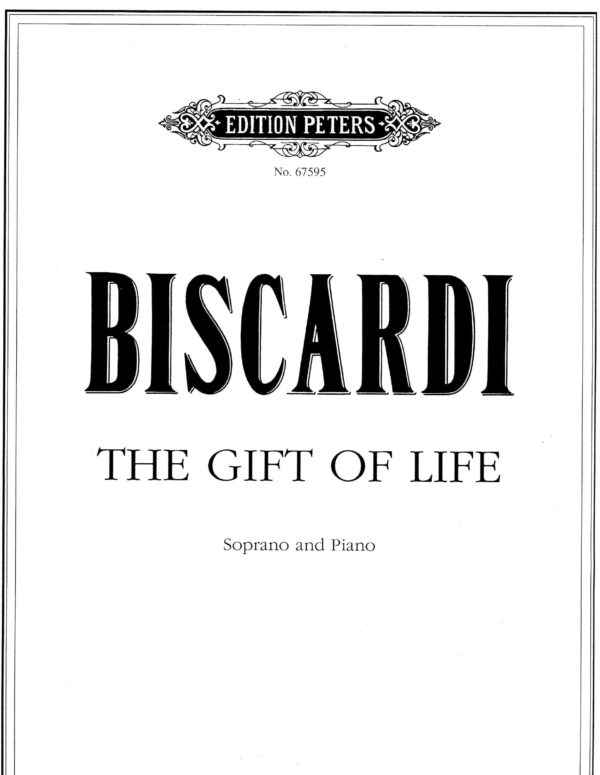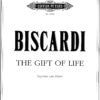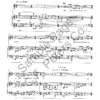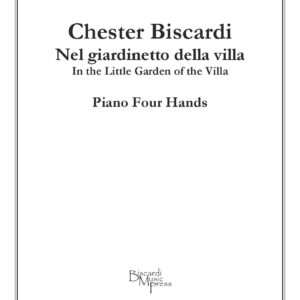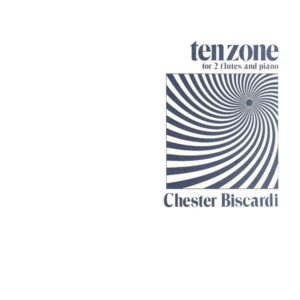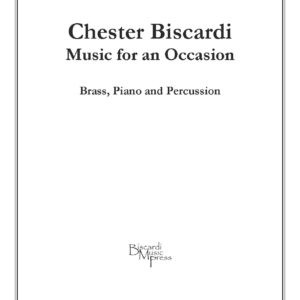Description
Premiere
Excerpt: Lullaby, for Ariana Tamar Goldsworthy or "Mama Never Forgets Her Birds":
11 October 1991
Judith Bettina, soprano / James Goldsworthy, piano
Stanford University
Palo Alto, CA
First Performance: 27 June 1993
Judith Bettina, soprano / James Goldsworthy, piano
First Congregational Church
Palo Alto, CA
Text
Emily Dickinson ("Mama never forgets her birds"), Denise Levertov ("The 90th Year," for Lore Segal, from the Homage to Pavese section of Life in the Forest) and Thornton Wilder (adapted from The Bridge of San Luis Rey)
Vocal Range
Dedication
for Judith Bettina
Publisher
C. F. Peters No. P67595
Classical Vocal Reprints No. EP67595
Program Notes
The Gift of Life, for soprano and piano (1990-1993), is a song cycle with texts by Emily Dickinson, Denise Levertov and Thornton Wilder. These songs were written for soprano Judith Bettina, who first performed them with her husband, James Goldsworthy, in Palo Alto, California on June 27, 1993. The poem by Emily Dickinson, “Mama Never Forgets Her Birds,” is set as a lullaby, written to celebrate the birth of their daughter, Ariana Tamar Goldsworthy. The cycle, continuing with “The 90th Year,” by Denise Levertov, and an adaptation of the last lines of Thornton Wilder’s The Bridge of San Luis Rey, speaks of birth, life, memory, loss, death, and, finally, love. This cycle grew directly from my work with text and characters in Tight-Rope, an opera I wrote with Henry Butler in 1985. In these songs I chose texts according to their power to generate musical images concerning memory, time, and the cyclical nature of existence, themes which are recurrent in my music.
Though in another tree—
She looks down just as often
And just as tenderly
As when her little mortal nest
With cunning care she wove—
If either of her “sparrows fall,”
She “notices,” above.
Emily Dickinson poetry is used by permission of the publishers and the Trustees of Amherst College from THE POEMS OF EMILY DICKINSON, Thomas H. Johnson, ed., Cambridge, Mass.: The Belknap Press of Harvard University Press, Copyright © 1951, 1985, 1979, 1983 by the President and Fellows of Harvard College.
of a small bird’s curlicue of song—too high
for her to see or hear.
I’ve learned
not to say, these last years,
‘O, look!—O, listen, Mother!’
as I used to.
(It was she
who taught me to look;
to name the flowers when I was still close to the ground,
my face level with theirs;
or to watch the sublime metamorphoses
unfold and unfold
over the walled back gardens of our street . . .
It had not been given her
to know the flesh as good in itself,
as the flesh of a fruit is good. To her
the human body has been a husk,
a shell in which souls were prisoned.
Yet, from within it, with how much gazing
her life has paid tribute to the world’s body!
How tears of pleasure
would choke her, when a perfect voice,
deep or high, clove to its note unfaltering!)
She has swept the crackling seedpods,
the litter of mauve blossoms, off the cement path,
tipped them into the rubbish bucket.
She’s made her bed, washed up the breakfast dishes,
wiped the hotplate. I’ve taken the butter and milkjug
back to the fridge next door—but it’s not my place,
visiting here, to usurp the tasks
that weave the day’s pattern.
Now she is leaning forward in her chair,
by the lamp lit in the daylight,
rereading War and Peace.
When I look up
from her wellworn copy of The Divine Milieu,
which she wants me to read, I see her hand
loose on the black stem of the magnifying glass,
she is dozing.
‘I am so tired,’ she has written to me, ‘of appreciating
the gift of life.’
“The 90th Year” (for Lore Segal) from the Homage to Pavese section of Life in the Forest
Copyright © 1976 by Denise Levertov. Used with permission of the publisher,
New Directions Publishing Corporation.
and all memory of those we have lost
will have left the earth . . .
We shall die
and all memory of those we have lost
will have left the earth,
and we ourselves shall be loved for a while
and forgotten.
The love will have been enough;
all those impulses of love return to the love that made them.
There is a land of the living and a land of the dead,
and the bridge is love, the only survival, the only meaning.
Adapted from Thornton Wilder’s The Bridge of San Luis Rey
Copyright © 1927, by Albert and Charles Boni, Inc.
Copyright Renewal © 1985, by Thornton Niven Wilder
ALL RIGHTS RESERVED: All inquiries concerning rights should be addressed to the author’s agent, ROBERT A. FREEDMAN AGENCY, INC., at 1501 Broadway, Suite 2310, New York, New York 10036.
Edition Peters No. 67598
Copyright © 1994 C. F. Peters Corporation
Press
In these songs I chose texts according to their power to generate musical images concerning memory, time, and the cyclical nature of existence, themes that are recurrent in much of my vocal as well as instrumental music.A cycle in the true sense of the term, there is a continuous flow from one text to another, with few discernible divisions or traditional cadences. It is a kind of dramatic scene, if not a mini-opera, and the idiomatic vocal writing is very lyric and extraordinarily beautiful.
The piece opens with a characteristic motive that appears in various guises (enharmonic, retrograde, rhythmically altered, etc.) and transpositions throughout the cycle. In fact, the three pitches – E#, G#, and F# – are pivotal to the work, both linearly and harmonically, in voice and piano. These are powerful texts, although with a gentle philosophy, and the melodic lines are consistently and expressively evocative of the emotions of the texts.
The setting of Emily Dickinson's "Mama never forgets her birds . . .," which opens the piece, is nearly perfect in its matching of harmonic rhythm to poetic rhyme and meter. (Robert Carl, Fanfare, 1995)The rather static – but by no means uninteresting – rhythmic structure reflects the meditative quality of the work. In view of the Schubert analogy established earlier, another apt comparison occurs in Biscardi's use of recitative-like, parlando passages, sometimes unaccompanied, for particularly dramatic effect. At the end of this moving cycle, the text affirms that "the bridge is love," connecting the living to the dead, lifting the numbness of loss, and allowing us to be free; at this intensely expressive moment, the chief motive, introduced in the opening lullaby, reappears, tying the whole work together. That the motive remains incomplete in the voice part at the end may suggest that the individual is left to fulfill the "meaning."
The song cycle was composed for Bettina and Goldsworthy, who perform it here [At the Still Point CRI CD 686] as they did for the work's premiere in 1993. It begins with an exquisite setting of one of Emily Dickinson's most tender poems, which opens this way:
Mama never forgets her birds,
Though in another tree --
She looks down just as often
And just as tenderly.
Dickinson wrote this in memory of an aunt who had died and likened her departure from this world to a bird flying from one tree to another, yet still looking down on her baby birds with concern and affection. Biscardi's sensitive treatment of this text is breath-takingly beautiful, and it draws us inexorably into the rest of this work and exploration of, in Biscardi's words, "birth, life, memory, loss, death, and finally, love." The middle portion of the work is based on a text from Denise Levertov's Life in the Forest, a woman's thoughtful reflection on her own mother who seems about to slip away from her. This text is less poetic, at least in the conventional sense of the word, which makes it all the more challenging to set to music, but Biscardi responds beautifully with music that gently breathes life into the text without obscuring it. The third and final portion of the text is from Thornton Wilder's The Bridge of San Luis Rey and speaks powerfully and persuasively of the finality of death and of our own eventual oblivion, but also of the importance of love as the last and, in fact, only bridge between life and death. Here, as throughout the piece, Biscardi writes with a striking mix of sparseness and warmth, and the text is treated with such loving care. Judith Bettina sings beautifully and Jim Goldsworthy offers sensitive accompaniment at every turn.
So yet again, we are left tantalized by the songs of Chester Biscardi and hungry to hear more. May our wait be brief.
The vocal line is predominantly lyrical in a syllabic setting. There are many skips and leaps, some measured recitative, some phrases that cover the staff, several phrases that lie low in the range, many accidentals, and specific expressive markings. The piano part is melodic and mostly linear with some chordal sections, mildly dissonant tone clusters, many accidentals, and some rather wide reaches in places. An attractive and accessible cycle for both performers and audience, this would be an excellent work for a graduate level soprano with an even scale.


